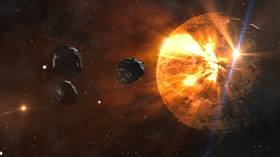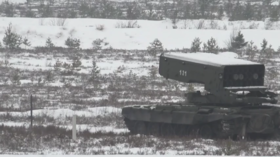Five asteroids inbound THIS WEEK as 2020’s relentless onslaught continues

NASA is reporting that at least five asteroids are headed towards Earth this week, adding yet another ominous threat people should watch out for.
According to NASA’s Center for Near-Earth Object Studies (CNEOS), four of the near-Earth objects are due to fly past the planet on Tuesday, June 2.
Kicking things off will be the 108-foot wide 2020 KK7, cruising along at 34,000mph. It is due to skim past the Earth at 4:43am EDT, at a merciful distance of roughly 319,000 miles, or just beyond the Moon. Close one.
Next up will be 2020 KD4, measuring 115 feet wide, with a velocity of almost 12,000 miles per hour, which will pass us at 8:47am EDT, at a distance of 2.5 million miles away.
The biggest of Tuesday’s bunch, the 144-foot 2020 KF, will shoot past our planet at 24,000 miles per hour some 2.9 million miles away, at 12:00pm EDT.
Also on rt.com Unexplained anomaly weakening Earth’s magnetic field is EVOLVING and SPLITTING in two, warn scientistsBringing up the rear in Tuesday’s space rock parade will be 2020 KJ1, measuring a relatively paltry 105 feet and plodding along at 11,000 miles per hour. The asteroid will wrap up Tuesday’s celestial spectacle at 2:57pm EDT, passing some 1.3 million miles from the Earth at its closest point.
Then, after a brief respite, an asteroid potentially taller than New York’s Empire State Building and the London Eye combined, 2002 NN4, will zoom by on Saturday, June 6.
潜在的に危険な #小惑星 (PHA)アテン型の(163348)=2002 NN4が2020年6月6日に地心から約511万km(月迄の距離の13倍)まで近づきます. この天体は2002年7月9日に米国,ニューメキシコのLincoln Observatory ETSで発見されたもので推定直径は250-570mです. https://t.co/77MveSCLKdhttps://t.co/f3LygyjTdMpic.twitter.com/ruqdZxJuss
— Atsuo ASAMI 浅見敦夫 (@AsamiAtsuo) May 24, 2020
2002 NN4 is an Aten-class asteroid which boasts a very wide orbit around the Sun and measures between 820ft and 1870ft, based on its brightness and the way it reflects light.
Somewhat surprisingly, the asteroid is considered ‘small’ in absolute terms and yet it is still bigger than roughly 90 percent of the asteroids we encounter in our solar system, which are approximately football-field size.
Thankfully, and despite its classification as a Near-Earth Object or NEO, 2002 NN4 will pass us at a very safe distance of 3,168,993 miles.
NEOs are space rocks that come within 1.3 astronomical units of the Earth, or 1.3 times the distance between Earth and the Sun.
Also on rt.com One of Earth’s main planetary defense telescopes just spotted a NEW kind of ASTEROID… with a tailHowever, lest we get too comfortable, 2002 NN4 is estimated to revisit us some time in 2024 and its orbit may be shifted in the intervening period by other space debris or planetary gravitational force, potentially deflecting it into a collision course with Earth. Therefore, CNEOS boffins will be keeping a close eye on it for a while longer.
Think your friends would be interested? Share this story!













